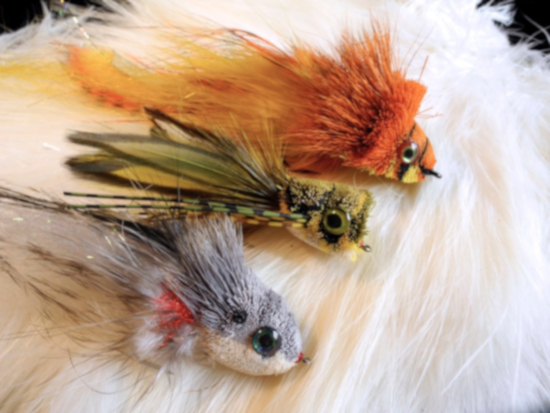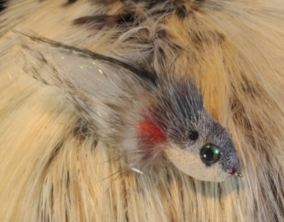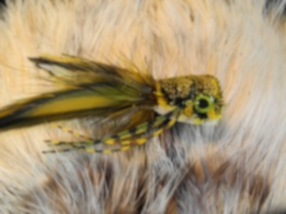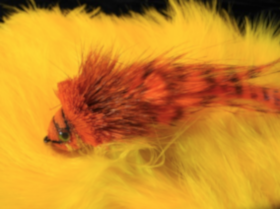
I wrote the following article for the inaugural edition of the Whiting Farms Pro Team newsletter. It was sent to all the pro team members. As I researched the article, I exchanged several emails with Dr. Tom Whiting who was very helpful in my understanding of the history of this line of birds.
Introduction
Richard Munoz of Whiting Farms 5irst introduced me to Bird Fur about 4 years ago. Seeing its potential, I began to incorporate it in to my warm water fly patterns with great results. Today it’s one of the main pelts that I rely on to provide movement and texture in many of the Flies I tie for Bass, Pike and Musky. Bird Fur was a name coined by one time marketing manager Steve Schwietzer. The catchy title really captures the nature of this feather. The Bird Fur pelt is the rooster cape of the spey line of birds. At one time “Spey Cock” feathers came from a line of special roosters from the Spey River Valley of Scotland. Around the beginning of the 20th century this line of birds began to dwindle and feathers from various Huron species began to be used in its place. However, with legal protection of Herons, a need arose for a suitable replacement. Dr. Tom Whiting began working on a spey line of birds in the mid 1990’s. For about 10 years, with the help of pro team members he developed the line. Today this line of birds provides a variety of feather pelts, which include rooster capes, rooster saddles, hen capes, hen saddles and roster breast pelts. These various pelts have a variety of applications, including warm water fly patterns.
The Bird Fur Feather
The Bird Fur feather is unique in its’ appearance. I’ve not found another pelt that has the same properties as this one. The base of the feather has marabou like barbs and the shaft or rachis is solid providing a good tie in point. As you move toward the tip of the feather the rachis becomes very slender along with long slender barbs. The feather naturally has a tapered profile. Used sparingly, this can introduce some very subtle texture to a fly. If more feathers are used, it still provides for a tapered profile unlike marabou, whose feathers have very square, blunt tips.
Waking Shad Minnow
The Waking Shad Minnow is a great pattern for many warm water species. This fly has a great minnow silhouette and creates a subtle disturbance when retrieved through the water. The addition of grizzle bird fur on this pattern has added a subtle barring on the sides and provided for better movement in the water. I fish this fly on a clear intermediate sink tip with a 5luorocarbon leader. Using short strips of line in retrieving this fly it simulates a struggling minnow in the surface, which is an almost irresistible trigger for fish.
Deer Hair Bass Bugs
I have been tying and fishing deer hair bass bugs for almost 3 decades. At times, the search for appropriate tailing materials has been challenging. I like using natural materials for the tails. The tail must balance with the deer hair head. By that I mean if the tailing material is too sparse the deer hair head overwhelms the tail and the fly does not fish and behave properly in the water. Also, when the fly is just sitting in the water it doesn’t present a proper profile. At the opposite end of the spectrum the tail of the fly can be overdressed and too bulky. I like a split feather tail and having a centering material to aid in making the feather wings splay is very helpful. Additional this centering material helps in creating a transition from the body of the fly to the tail. I have tried marabou, however, it easily overdresses the fly and obscures the split feather tails. Bird Fur works uniquely well for this purpose. The marabou like base provides a nice transition from the head to the tail, however the natural taper in the feather allows the split tails to stand out creating a nice balance to the fly.
Diving Deer Hair Pike/Musky Fly
Tying a diving deer hair head with rabbit strip tail is a fly pattern that has been around for a long time. My early efforts at this fly usually involve tying on the rabbit strip and then spinning a deer hair head. While the fly caught fish I was never satis5ied with the transition between the head and the rabbit strip tail. A few years ago when barred and multicolored rabbit strip tails began to appear, I became very motivated to create a diving fly using this material, however, the transition between the head and the tail were still an issue. I tried both Artic Fox and marabou with mixed results. The pattern really came together when I switched to a Bird Fur collar. With different colors and types of Bird Fur, I was really able to match the color scheme of the rabbit. I especially like the grizzly as it blended well with the barring on the rabbit strips. Since the feather has a natural taper, the fly has a great transition from the head to the tail. When fished and viewed from underneath, the fly has a fish-like profile. The Bird Fur collar on this fly really completes the pattern.
Conclusion
Bird Fur is really a unique material and these three patterns only scratch the surface of what can be done with these feathers. Streamers, swinging spey Flies, and wooly buggers are only a few of the other fly patterns where Bird Fur feather could be used.
Fly Patterns

- Hook: TMC 8089N(#6)
- Thread: UTC 140 Black (for the Tail); UTC GSP (Gel Spun) 200 (for Head)
- Tail: Gray over White Icelandic Sheep with Larva Lace Angle Hair Pearl Sparkle. Grizzle Bird Fur on sides, Black bird Fur on top
- Gills: Hairline Ice Fur (Red)
- Head: Dun Grey Deer over White Deer
- Eyes: Clear Cure Eyes (6mm, Agate)

- Hook: TMC 8089 (#6)
- Thread: UTC 140 Black (for the Tail); UTC GSP (Gel Spun) 200 (for Head)
- Tail: Olive Grizzle over Cream Bird Fur with Larva Lace Angle Hair Pearl Sparkle. Olive, Yellow and White Whiting Black‐Laced Hen on sides, Olive and Yellow Whiting American Collar
- Head: Olive, Yellow, and Black Deer over White Deer
- Legs: Hareline Grizzle Barred Rubber Legs Medium (Olive and Yellow)
- Eyes: Clear Cure Eyes (6mm, Monster)

- Hook: Mustad C52SBLN (#2/0)
- Thread: TC 140 Black (for the Tail); UTC GSP (Gel Spun) 200 (for Head)
- Tail: Montana Fly Black Barred Yellow/Orange Rabbit over Yellow Yack Hair with Holographic Flashabou
- Collar: Whiting Grizzle Orange over Yellow Bird Fur
- Head: Orange and Black Deer over Yellow Deer
- Eyes: Clear Cure Eyes (6mm, Solar Flare)